Related Research Articles
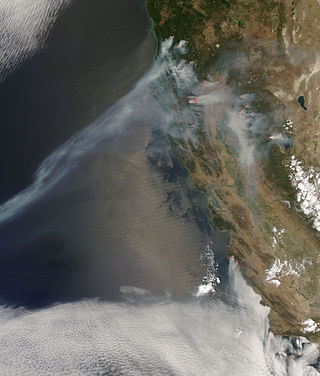
The 2008 California wildfire season was one of the most devastating in the state of the 21st century. While 6,255 fires occurred, about two-thirds as many as in 2007, the total area burned— 1,593,690 acres —far exceeded that of previous years.
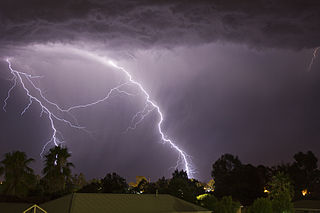
A dry thunderstorm is a thunderstorm that produces thunder and lightning, but where all or most of its precipitation evaporates before reaching the ground. Dry lightning refers to lightning strikes occurring in this situation. Both are so common in the American West that they are sometimes used interchangeably.

In the summer of 2013, there were several major wildfires in Colorado in the United States. During June and July, record high temperatures and dry conditions fueled the fires all across the state. By July 24, 570 structures had been destroyed and 2 people died. Below is a list of the major fires of the year.

The 2015 California wildfire season was a series of wildfires that burned across the state of California. By the end of 2015 a total of 8,745 fires were recorded, burning 893,362 acres (3,615 km2) across the state. Approximately 3,159 structures were damaged or destroyed by wildfires, and at least 7 fatalities were recorded.
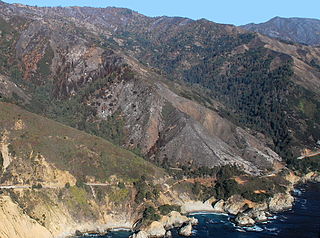
The Basin Complex Fire was a massive wildfire near Big Sur that ignited on June 21, 2008, and was the result of a lightning strike. It eventually grew to 162,818 acres (658.90 km2), becoming the second-largest wildfire of the 2008 California wildfire season and burning most of the Ventana Wilderness. State and federal officials spent more than $120 million to fight the fire, making it the most expensive fire in California history up to that point and the second most expensive in U.S. history, exceeded only by the Biscuit Fire in 2002. Eventually, the Thomas Fire surpassed the Basin Complex Fire in firefighting costs as well.
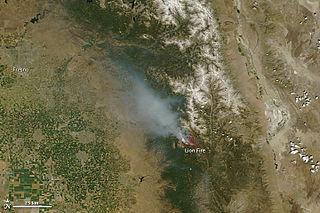
The Lion Fire was the 3rd largest fire of the 2011 California wildfire season. The fire, which was the result of a lightning strike, burned 20,674 acres (84 km2) of land in the Sequoia National Forest. As the fire grew it forced the evacuations of many popular campgrounds in Sequoia National Park.

The Frog Fire was a fatal fire that occurred during the 2015 California wildfire season that burned 4,863 acres (1,968 ha) of land in the Modoc National Forest. The fire was one of many fires that was started on July 30 during a lightning storm.
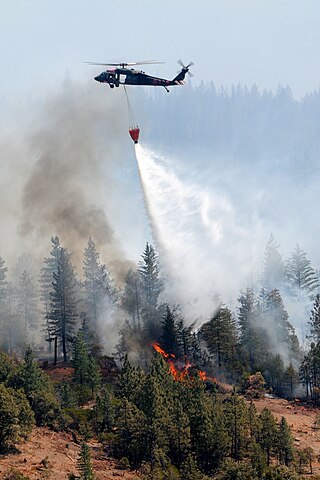
The Ponderosa Fire was a destructive wildfire during the 2012 California wildfire season. While the fire only burned 27,676 acres (11,200 ha), it destroyed 133 structures, the most of any fire that year for the state. At the height of the fire on August 24, over 2,300 firefighters were involved in the suppression effort, which also included 254 fire engines, 46 bulldozers and 54 water tenders.

The Schaeffer Fire was a wildfire in the Kern River Ranger District of the Sequoia National Forest in Tulare County, California in the United States. It was caused by a lightning strike on June 24, 2017. The fire crept through the old burn area of the 2002 McNally Fire for several days before growing to over 580 acres on June 28. The fire was contained by August 10 and destroyed a total of 16,031 acres (65 km2).

The Klamath Theater Complex Fire, also known as the Bear Wallow Complex Fire, was the largest wildfire of the 2008 California wildfire season. The complex fire originated as 11 separate wildfires, before merging into a single massive complex fire that burned 192,038 acres (777.15 km2) in Northern California, and lasted for over 3 months. The progenitor fires of the fire complex were all caused by lightning. As of 2024, the Klamath Theater Complex Fire was the 19th largest fire in modern California history. The complex fire killed a total of two firefighters.

The 2020 Loyalton Fire was a large wildfire in Lassen, Plumas and Sierra counties in California and Washoe County in Nevada. After it was ignited by lightning on August 14, 2020, the fire burned 47,029 acres (19,032 ha) in the Tahoe National Forest and the Humboldt-Toiyabe National Forest before it was fully contained on August 26. The Loyalton Fire was notable for generating three fire tornadoes on August 15, necessitating first-of-their-kind warnings by the National Weather Service.

The LNU Lightning Complex fires were a large complex of wildfires that burned during the 2020 California wildfire season across much of the Wine Country area of Northern California – Lake, Napa, Sonoma, Solano, and Yolo Counties, from August 17 to October 2, 2020. The complex was composed of numerous lightning-sparked fires, most of which were small. While they ignited separately from each other, the Hennessey Fire eventually grew to merge with the Gamble, Green, Markley, Spanish, and Morgan fires, scorching 192,000 acres (777 km2) by itself, for a total burn area of 363,220 acres (1,470 km2) in the complex. The fire, which burned in the hills surrounding several large cities, such as Fairfield, Napa, and Vacaville, destroyed 1,491 structures and damaged a further 232. In all, six people were killed and another five injured. The LNU Lightning Complex is the seventh-largest wildfire in the recorded history of California.

The August 2020 California lightning wildfires were a series of 650 wildfires that ignited across Northern California in mid-August 2020, due to a siege of dry lightning from rare, massive summer thunderstorms, which were caused by an unusual combination of very hot, dry air at the surface, dry fuels, and advection of moisture from the remains of Tropical Storm Fausto northward into the Bay Area. These fires burned between 1,500,000 acres (6,100 km2) to 2,100,000 acres (8,500 km2) within a 2–3 week period. The August 2020 lightning fires included three enormous wildfires: the SCU Lightning Complex, the August Complex, and the LNU Lightning Complex. On September 10, 2020, the August Complex set a record for the single-largest wildfire in the modern history of California, reaching a total area burned of 471,185 acres (1,907 km2). On September 11, the August Complex merged with the Elkhorn Fire, another massive wildfire of 255,039 acres (1,032 km2), turning the August Complex into a monster wildfire of 746,607 acres (3,021 km2).

The CZU Lightning Complex fires were wildfires that burned in Northern California starting in August 2020. The fire complex consisted of fires in San Mateo and Santa Cruz counties, including fires that had previously been separately tracked as the Warnella and Waddell fires. The firefighting effort was primarily administered by the California Department of Forestry and Fire Protection.

The August Complex was a massive wildfire that burned in the Coast Range of Northern California, in Glenn, Lake, Mendocino, Tehama, Trinity, and Shasta Counties. The complex originated as 38 separate fires started by lightning strikes on August 16–17, 2020. Four of the largest fires, the Doe, Tatham, Glade, and Hull fires, had burned together by August 30. On September 9, the Doe Fire, the main fire of the August Complex, surpassed the 2018 Mendocino Complex to become both the single-largest wildfire and the largest fire complex in recorded California history. On September 10, the combined Doe Fire also merged with the Elkhorn Fire and the Hopkins Fire, growing substantially in size. By the time it was extinguished on November 12, the August Complex fire had burned a total of 1,032,648 acres (417,898 ha), or 1,614 square miles (4,180 km2), about 1% of California's 100 million acres of land, an area larger than the state of Rhode Island.

The Red Salmon Complex was a wildfire that burned 144,698 acres (58,557 ha) in Humboldt, Trinity, and Siskiyou County in Northern California during the 2020 California wildfire season. On July 27, lightning strikes in the Trinity Alps Wilderness started two fires, the Salmon Fire and the Red Fire, which eventually merged. As the fire grew, hazardous smoke levels surrounded Forks of Salmon, Orleans, Yreka, and Weed.
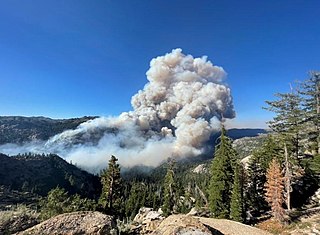
The Tamarack Fire was a wildfire that burned 68,637 acres (27,776 ha), primarily in the Mokelumne Wilderness in Alpine County, California, Douglas County, Nevada and Lyon County, Nevada, as part of the 2021 California wildfire season.

The River Complex 2021 was a wildfire complex burning in Klamath National Forest in Siskiyou County, California in the United States. The complex comprises over 20 wildfires that started as a result of lightning strikes during a series of thunderstorms in late July 2021. As of 25 October 2021, the fire had burned a total of 199,343 acres (80,671 ha) and became 100% contained. The largest fires in the complex were the Haypress–Summer Fire and the Cronan Fire.

The 2024 Waterman Fire was a wildfire that burned across 3,059 acres in Yavapai County, located in the U.S. state of Arizona. It started due to lightning on July 25, 2024, and was declared 100% contained on July 30.
References
- ↑ Kemp, Kym (31 July 2015). "[UPDATE 12:57 a.m.] Over 300 Lightning Strikes This Afternoon, Multiple Reports of Fires". Redheaded Blackbelt. Retrieved 2021-04-08.
- 1 2 3 "Humboldt Lightning Fires". www.fire.ca.gov. California Department of Forestry and Fire Protection (Cal Fire). Archived from the original on September 29, 2023. Retrieved March 28, 2024.